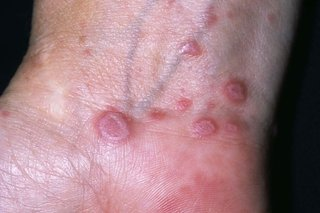Lichen planus is a condition affecting the skin and sometimes the mouth. It’s not uncommon and can be quite pesky. The bumps and discomfort it causes make early detection important. Mostly affecting adults, especially those who are middle-aged, it’s essential to recognize the signs and act.
Introduction to Lichen Planus
Lichen planus is a skin disorder. It’s typically seen as a rash that features small, itchy bumps that are purple or reddish. Knowing about lichen planus is important for keeping tabs on our health. Being informed helps in managing it better. There are plenty of myths around lichen planus. For example, people might think it’s contagious—it’s not, rest assured.
Recognizing the Symptoms of Lichen Planus
Symptoms can be these itchy, purple, bump-like rashes on the skin. In the mouth, it can appear as sores or lesions, which might make eating uncomfortable. Sometimes, lichen planus shows up on the nails and scalp. Nail symptoms can include ridges or thinning, while scalp involvement might lead to hair loss.
Identifying the signs early can help in seeking timely medical consultations, making management more straightforward.
Demystifying the Causes and Risk Factors
The causes of lichen planus aren’t crystal clear. However, potential triggers include medications, hepatitis C, and stress. It’s believed to result from an immune system response. Despite common myths, lichen planus is not contagious. Understanding these aspects helps in managing or even preventing the condition.
Effective Diagnosis and Understanding Triggers
Doctors usually diagnose lichen planus by looking at the symptoms on the skin or inside the mouth. In some cases, they may perform a biopsy to get a deeper look. Blood tests can rule out issues like hepatitis C. Getting a professional assessment ensures an accurate diagnosis.
Exploring Treatment Options for Lichen Planus
Treatments for lichen planus can vary. Often, doctors prescribe topical creams like corticosteroids to help ease the discomfort. In other cases, immune-modulating medications might be used. For those with mild symptoms, sometimes simple care at home is enough.
- Try soothing baths with oatmeal.
- Use moisturizer regularly.
- Stay away from scratchy fabrics.
Some might explore alternative therapies, but it’s important to consult with a healthcare provider first. Lifestyle changes, like reducing stress and eating a balanced diet, may also support treatment efforts.
Living with Lichen Planus: Management and Coping
Lichen planus often has a course that can involve flare-ups over time. While it might recede on its own, some might experience recurrence. Handling lichen planus involves strategies like keeping skin moisturized and handling stress efficiently. Adapting to lifestyle changes can improve overall comfort and quality of life.
When to Seek Medical Help
If you notice persistent rashes or nail changes that don’t go away, it’s time to see a doctor. It’s crucial to seek help when symptoms are severe or if complications seem to arise. With the right medical assistance, managing lichen planus becomes much easier.
Conclusion: Navigating Life with Lichen Planus
While lichen planus might seem daunting, remember that treatments can be very effective. Managing your health proactively and consulting professionals when needed is key. Looking forward, we remain optimistic about new treatments that may be on the horizon, making living with lichen planus more manageable than ever.


